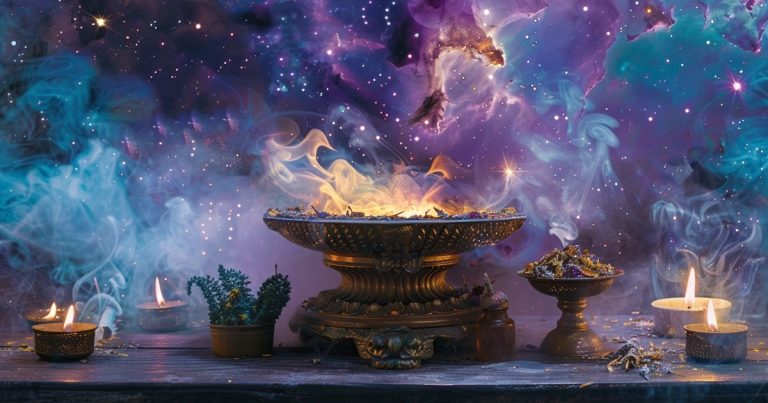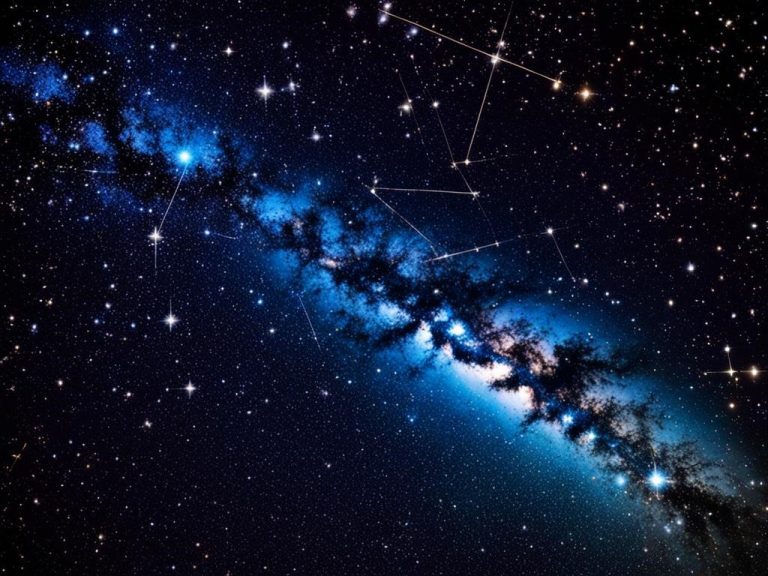Explore the Wonders of the Ara Constellation
Modified: September 1, 2024 Author: International Star Registry
Welcome to the mesmerizing world of the Ara Constellation, a small but captivating group of stars located in the southern hemisphere. It’s between the Scorpius and Triangulum Australe constellations. Ara’s rich history and mythology make it more fascinating. The Ara Constellation is named after the Latin word for “altar”. This name shows its deep meaning and importance.
One of the most notable stars in Ara is Beta Arae, a stunning binary star system about 600 light-years away. Look at the night sky, and you’ll see its brilliance. It’s a glimpse into the vast universe that will keep you in awe.
The Ara Constellation has cultural connections with South American indigenous peoples and ancient Greek myths. Both saw it as a sacred altar. This connection adds mystery and makes Ara an exciting topic to explore.

Key Takeaways:
- The Ara Constellation is a small yet captivating star group located in the southern hemisphere.
- It is named after the Latin word for “altar,” symbolizing its historical and cultural significance.
- Beta Arae, a binary star system within the constellation, boasts stunning brilliance.
- The Ara Constellation has deep roots in indigenous South American cultures and Greek mythology.
- Exploring the wonders of the Ara Constellation opens up a world of celestial fascination.
The History and Mythology of the Ara Constellation
The Ara constellation has a rich story and mythology. Covering 237 square degrees, it is the 63rd smallest. Only observers south of 22°N can see it.
Ara is surrounded by Scorpius, Norma, and Triangulum Australe. This makes it a key part of the southern sky.
In old times, South American indigenous people saw Ara as a sacred altar in the sky. They thought offerings were placed on it for the gods. Ara’s link to an altar is also strong in Greek myths.
Greek myths tie Ara to Heracles’ (Hercules’) story. Heracles killed the tormenting eagle of Prometheus, making it the Aquila constellation. For this, Zeus put Ara next to Aquila as an honor.
There’s another tale. Zeus and the Gods made a promise on Ara, facing off Cronus and the Titans. This shows the value of oaths and respects among the gods.
One more myth says Ara is from King Lycaon of Arcadia, who fed Zeus human flesh. Zeus turned him and his sons into wolves. Their story became the constellation Lupus.
The Ara constellation’s stories and history make it special. Today, Ara links us with ancient beliefs in the sky.
Naming a Star in the Ara Constellation
Did you know you can name a star in the Ara Constellation? International Star Registry offers this chance. It’s perfect for a birthday, anniversary, or any special day.
Visit starregistry.com to pick a star in Ara. You can give it a special name. This gesture means love, remembrance, and a strong bond.
Your special someone will always remember you when they see their star in the sky.
How to Buy a Star in the Ara Constellation
Buying a star in the Constellation Ara is easy and meaningful. Go to starregistry.com to pick your star. You can give it a special name. The whole process to buy it online is simple. This gift is unique and will always remember.
When you buy a star, you get to name one in Ara. You also get a certificate. This proves the star has your name or the name you chose.
Buying a star is great for love, special gifts, or remembering someone. The Ara Constellation is a beautiful place in the sky. Naming a star brings a deep connection and memories. The love for it will last a long time.

The Significance of Naming a Star in the Ara Constellation
Did you know that you can immortalize your loved ones by naming a star in the Ara constellation? Through International Star Registry, you can give the gift of a star to someone special for birthdays, Christmas, anniversaries, or any other occasion. Imagine the joy and wonder on their faces as they gaze up at the night sky, knowing that a star shines brightly just for them.
Ara Constellation: A Testament to Human Curiosity
The Ara Constellation has intrigued people for ages. Its name means “altar” in Latin, its shape resembling one. It has been studied for its unique features. These studies deepen our universe’s understanding.
The Beauty and Wonder of the Night Sky
Looking at the night sky fills us with awe. Stars have inspired myths, stories, and art for generations. By naming a star in Ara, we celebrate this beauty. It makes us feel part of something big.
A Timeless and Personal Gift
Naming a star is a special and personal choice. It lets you honor someone dear and create a legacy. This gift is timeless, perfect for any occasion. It will be treasured long after it is given.
The Stars of the Ara Constellation
The Ara Constellation lights up the night sky. One star, Beta Arae, shines the brightest. It’s about 600 light-years from Earth. Beta Arae is a special part of the Ara Constellation, making it more amazing to look at by those who love the stars.
Beta Arae has two stars that move around each other. This makes a stunning sight for watchers. When one star covers the other, the light we see changes. This change in light is interesting to study. It shows us how beautiful and complicated space is.
Besides Beta Arae, the Ara Constellation has many other stars. They all have their own features and tales. Together, they form a beautiful pattern in the sky.
In the Ara Constellation, you’ll find stars of all kinds. Some are big, some small, some bright, and some dim. Each star adds to the beauty of the constellation. They create a wonderful scene for everyone to enjoy, from those who study the sky to those who just love looking at it.
The best way to see Ara’s stars is far from city lights. Find a dark, clear place to really see them shine. This way, you can fully experience the beauty of these amazing stars.
The History and Mythology of the Ara Constellation
The Ara constellation is significant in both Ara and Greek mythologies. Its history is rich and full of stories. Let’s explore where it comes from and what it means.
In South America’s Ara myths, the constellation represented a sacred altar. This altar was where people made offerings to the gods. It showed the people’s connection to the divine. They often showed the altar in drawings, with its base to the north and flames rising south.
Greek mythology tells of Heracles and his feats. After a huge battle, Zeus put the Ara constellation in the night sky. It was to honor their victory and show thanks. This story gives another layer of meaning to the Ara constellation.
The Ara constellation’s story doesn’t end there. To the ancient Chinese, it meant something else entirely. They saw it as an edible tortoise and a rice-pounding pestle. These cultural ties make the Ara constellation even more fascinating.
If you want to learn more about the Ara constellation and its myths, check out these links: http://www.ianridpath.com/startales/ara.html, https://www.universetoday.com/19574/ara/, http://www.seasky.org/constellations/constellation-ara.html.
Next, we’ll dive into more detail on the Ara constellation. We’ll look at where it is, how we see it, and why it’s important to us.
The Visibility and Location of the Ara Constellation
The Ara Constellation is known as the Altar. It’s located in the southern part of the sky, between Scorpius and Triangulum Australe. It’s a beautiful part of the night sky.
In the southern hemisphere, people can easily see Ara during the summer months. But, if you’re in a different spot or season, it might not be as clear. From late spring to autumn, Ara’s beauty shines bright for viewers.
Want to find Ara in the sky? You can use star maps or special apps on your phone. These tools show you Ara’s exact position. Then, you can look up and see its wonders.

The Astronomical Significance of the Ara Constellation
The Ara Constellation is a captivating formation that astronomers and stargazers love. It is made up of bright stars and is really important in the sky.
The Ara Constellation looks like a celestial altar. It’s famous for this shape. According to Greek myths, it’s where the gods made a big promise before a huge battle.
This constellation is seen from the southern hemisphere. Its view changes from where you look. The stars in Ara show us the beauty and vastness of space, which interests many people.
The Constellation Ara has many Ara astronomy facts for those who love space. It has unique pairs of stars that orbit each other. This makes them special to see in the night sky.
Eta Arae is a star that stands out in Ara. It’s a system with two stars. One is a giant and the other is a dwarf. Studying this pair helps us learn about stars and how they change over time.
Each star in Ara adds to its beauty in the night sky. Together, they make a stunning picture of the universe for us to enjoy.
Studying Ara leads to new space discoveries. The wonders in Ara show us how big and complex the universe is. They leave us amazed at what we still have to understand.
The Celestial Altar: A Mythical Connection
The Ara Constellation’s link to an altar is both historic and mythical. In the past, people used altars to worship and ask for help from the gods.
This celestial altar highlights how the universe and people are connected. It shows us the power and importance of the stars.
This tale about a celestial altar makes Ara even more interesting. It makes us think about our place in the vast universe.
Naming a Star as a Perfect Gift for Any Occasion
Naming a star in the Ara Constellation through International Star Registry makes a perfect gift for any celebration. It’s great for birthdays, anniversaries, Christmas, or another big day. It’s a unique and thoughtful way to show you care and will leave a lasting memory.
By naming a star after someone, you give them a special, shining gift. It’s a sign of love, thankfulness, and a bond that lasts forever. Each time they see the stars, they’ll think of you and the unique connection you have.
Whether it’s to mark a big moment, remember a loved one, or just show you care, naming a star in the Ara Constellation is a top choice. It’s a timeless gift that will make them happy and in awe. It will be a memory they treasure forever.
Conclusion
The Ara Constellation is a captivating group of stars. It sits between the Scorpius and Triangulum Australe constellations. Ara is known for its interesting history and stories from different cultures.
One star in Ara, Beta Arae, is very bright. It shines from about 600 light-years away. This shows how vast and intriguing our universe is.
Naming a star in Ara is easy and meaningful with International Star Registry. It’s a special gift for many occasions. This gift represents lasting love, memory, and connection.
When the recipient sees their named star, it brings back memories of the person who gave it to them.
Are you thinking about creating a lasting memory? Visit starregistry.com to learn about Ara. You can buy a star there as a unique present for someone special.
Ara has many fascinating objects to discover. It includes an open cluster and a planetary nebula. These are just a few examples waiting for you to explore.
Don’t miss this chance to give an extraordinary gift. Name a star in Ara through International Star Registry. Let it bring light and joy for generations.
FAQ
What is the Ara Constellation?
The Ara Constellation is a small yet captivating group of stars in the southern skies. It sits between Scorpius and Triangulum Australe.
What is the history and mythology of the Ara Constellation?
Long ago, South American natives saw it as a sacred altar. The Greeks connected it to the hero Heracles in their myths.
Can I name a star in the Ara Constellation?
Yes, you can name a star in this constellation through International Star Registry.
How do I buy a star in the Ara Constellation?
Head to starregistry.com to pick a star. Then, you can personalize and buy it.
What is the significance of naming a star in the Ara Constellation?
It’s a timeless way to show love, remember someone, or feel connected deeply.
What are some of the stars in the Ara Constellation?
Beta Arae is a bright star in Ara. It’s actually two stars that orbit each other, 600 light-years from us.
What is the visibility and location of the Ara Constellation?
Ara’s visibility changes with the season and location. It’s seen well in the southern summer skies.
What is the astronomical significance of the Ara Constellation?
Ara is significant for its bright stars and history. It enriches our view of the universe’s night sky.
Is naming a star a perfect gift for any occasion?
Yes, naming a star in Ara is a special gift for birthdays, anniversaries, and various celebrations.
How can I name a star?
Go to starregistry.com, select a constellation, and name a star.
Source Links
